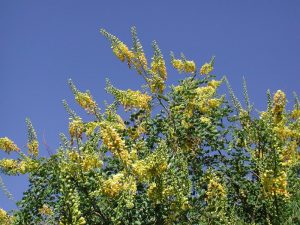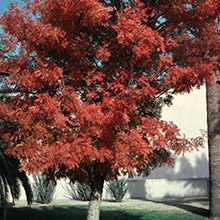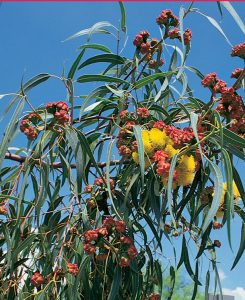Cities need trees, including our desert cities. Trees help to mitigate the heat island, reduce ground temperatures in the evening and remove pollutants from the air. Trees raise property values, save energy by shading walls and windows, and attract birds and other wildlife. Here’s the question: Why don’t we plant more of them?
Here’s one answer: Some people think of trees as messy. Yes, all trees drop at least some leaves, twigs, berries, blossoms, seeds and/or pods. For many people, this is a lovely natural way for trees to create their own mulch, add to the natural look of a landscape and feed wildlife.
For others, this is “litter” on their grass and gravel or in their pools. We hear you. Here’s a solution: 10 hardy, drought-tolerant trees you can plant that drop less than most trees. These trees often are called “pool friendly” trees.
- Arizona Rosewood (Vauquelinia californica): Shrubby evergreen that thrives in full sun or partial shade and grows to 10 feet. Clusters of white flowers in spring.
- Cascalote (Caesalpinia cacalaco): Evergreen that likes full sun and grows to 15 feet.Yellow flowering spikes winter through spring.
- Chinese Pistache (Pistacia chinensis): Large tree that likes full sun and grows to 40 feet. It turns a reddish orange in the late fall and drops its leaves (but all at once and once a year).

- Ironwood (Olneya tesota): Evergreen that likes full sun and grows to 25 feet. Lavender flowers in late spring.
- Leather Leaf Acacia (Acacia craspedocarpa): Evergreen that likes full or reflective sun and grows to 10 feet. Yellow puffy flowers spring into summer.
- Live Oak (Quercus virginiana): Evergreen that likes full sun and grows to 40 feet. Subtle green flowers in the spring.
- Red-Cap Gum (Eucalyptus erythrocorys): Evergreen that likes full sun and grows to 25 feet. Red berries that blossom yellow in the summer.
- Willow Acacia (Acacia salicina): Evergreen that likes full sun and grows to 30 feet. Puffy cream-color flowers in the spring.
- Texas Mountain Laurel (Sophora secundiflora): Shrubby evergreen that likes full sun and grows to 8 feet. Clusters of purple flowers in the spring.
- Silk Floss Tree (Chorisia speciosa): Evergreen that likes full sun and grows to 30 feet. Pink to red flowers in the fall then loses its leaves.
There are many more drought-tolerant trees, pool friendly or otherwise. Ask for help at your local nursery. Here are a few dos and don’ts before you buy and plant a tree.

- Do know how tall and how wide a tree will grow when mature. Fitting the right size tree in the right space keeps trimming to a minimum.
- Do ask your nursery expert if the tree will be healthier in the turf or arid area of your yard.
- Don’t buy a tree in less than a 15-gallon container.
- Don’t plant a tree too deeply. This is a common reason why trees fail to thrive. Allow the bell-shaped roots to protrude out of the ground.
- Don’t mix mulch with the desert soil. The soil gets hot, burns the mulch and leaves gaps around the roots. Put the mulch on top of the soil around the base of a tree.
- Do move your watering lines as a tree grows. Watering at the edge of the canopy helps the roots expand and keeps a tree solidly in the ground during the harshest winds.
Perhaps it’s time to make a contribution to your city’s urban forest. You’ll find more information about how to select, install and successfully grow trees (as well as shrubs, vines, and groundcover, grasses, cactus, and succulents) at AMWUA.org/landscape.
More details on how to care for your pool can be found at these suggested links from the Water – Use It Wisely resources page:
- Pools and Spas: Water Saving Tips and Technologies
- How to Drain or Backwash Your Pool
- Using Swimming Pool Water on Plants
- Saving Water in Swimming Pools: 5 Ways to Cut Evaporation
- Saving Water in Swimming Pools: 5 Ways to Cut Pool Water Loss
- How to Reduce Chemical Use in Your Pool
From time to time, Water – Use It Wisely features guest bloggers who write about topics related to water and water conservation. Kathy Ferris is the former executive director at Arizona Municipal Water Users Association (AMWUA). She has been involved in Arizona water issues for more than 38 years. Kathy was recently named as a senior research fellow for the Kyl Center for Water Policy at the Morrison Institute for Public Policy at Arizona State University. For more information, visit www.amwua.org.



